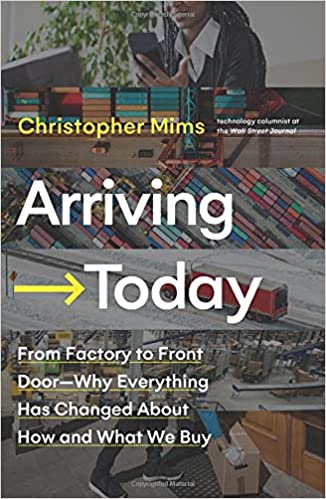You have /5 articles left.
Sign up for a free account or log in.
 Arriving Today: From Factory to Front Door—Why Everything Has Changed About How and What We Buy by Christopher Mims
Arriving Today: From Factory to Front Door—Why Everything Has Changed About How and What We Buy by Christopher Mims
Published in September 2021
Arriving Today could not be better timed. Pre-pandemic, the workings of the global supply chain were of little interest to most consumers. We mostly took it for granted that the stuff we ordered on Amazon would show up at our doors in a day or two.
Nowadays, each of us is a student of supply chain logistics.
Arriving Today is the go-to book to understand why the Asia-to-U.S. supply chain is stressed, disrupted and delayed. Written by the Wall Street Journal technology columnist Christopher Mims, Arriving Today traces the path of a USB charger from the factory gates in Vietnam to its final destination at our doorway.
As the U.S. makes little of the physical goods that we consume, almost all the stuff we buy needs to get here from somewhere else. For electronic goods, that place is almost always Asia. China still dominates in many areas of electronics, but rising wages in China have pushed manufacturing out to lower-wage countries such as Vietnam.
That USB charger that we order will begin its journey on a truck outside the Vietnamese factory and then move to a river barge on its way to more trucks before finally being loaded on a container ship in a shipping port. The first and longest leg of the supply chain is in a 40-foot container on a ship that can hold up to 12,000 of these boxes.
The backlog at the twin ports of Los Angeles and Long Beach, where 40 percent of the nation’s imported goods arrive, has emerged as one of 2021’s top news stories. Reading Arriving Today helps fill the picture out as to why these ports are so jammed up. Decades of chronic underinvestment in port-related infrastructure will mean that the shipping backlogs will not be addressed, even with ports operating 24-7. There are too few cranes and container chassis, dock space, warehouse space, and truckers to accommodate the COVID-driven surge in imports.
As Mims documents, the supply chain problems worsen once the shipping containers clear the port and make it onto the trucks that deliver our goods to sorting and distribution warehouses. Anyone worried that self-driving trucks will be coming soon and will displace the nation’s 3.5 million truck drivers should read Arriving Today.
Turnover among long-haul truck drivers is near 100 percent. The job, as it stands today, is underpaid and dangerous. Since the deregulation of the trucking industry in the 1970s, wages and working conditions for truckers have gotten worse, while the economy’s dependence on trucking has dramatically increased.
Autonomous driving technologies will be a long time coming for trucking, as truckers’ work is highly complex and variable. When autonomous driving technology evolves to a point where it can be rolled out, the benefits to truck drivers in making their jobs less exhausting and less dangerous should be immense.
The future of trucking will be drivers and technology working together, with truckers overseeing the driving and likely taking the wheel for last-mile deliveries to warehouses. This is a development that both truckers and all of us will welcome as progress.
From the truck, Mims then follows our USB charger deep into the Amazon warehouse system. If the lives of truck drivers are worrying, the plight of the Amazon warehouse workers that we all depend on is genuinely depressing. Even in Amazon’s most automated warehouses, it is still humans that do the demanding physical work of sorting, picking, boxing and loading. The pace that Amazon requires that its warehouse workers operate ensures both a high worker injury rate and exceptionally high turnover.
The story of how our USB charger gets from an Amazon fulfillment center to our home is only slightly less distressing than what occurs at the earlier links in the supply chain. If our package ends up on a UPS truck, the story is pretty good. UPS drivers are unionized and well compensated.
If, however, our package is delivered by an Amazon-branded delivery service, then the things are not so great. Those Amazon vans you see in your town are not owned by Amazon. Those Amazon delivery people wearing Amazon clothing do not actually work for Amazon. The company has set up a system where Amazon delivery drivers are much like Uber drivers—they are subcontractors and not employees. Amazon can benefit from lowering its delivery prices without dealing with pesky issues such as liability.
As we learn in Arriving Today, each supply chain link contains a myriad of ethical problems that are almost entirely invisible to consumers. Should those problems also be hidden from academia?
Colleges and universities buy lots of stuff. Many schools have tried to lower costs by centralizing purchasing through Amazon. Do we have a responsibility to the truckers, warehouse workers and delivery people we depend on to deliver goods to our campuses?
It may not be possible to ethically source all the stuff that higher education purchases. What we can do is educate our students about labor practices and labor history.
Our academic leaders can get in the fight for living wages and adequate workplace safety regulations. To the extent that our institutions are integrated into global supply chains, the responsibility to the workers we depend on does not end at our campus gates.
Reading Arriving Today will deepen and complicate your understanding of how the global economy functions. It is the perfect book to read as one contemplates the impact of the pandemic on our economy and society.
What are you reading?








